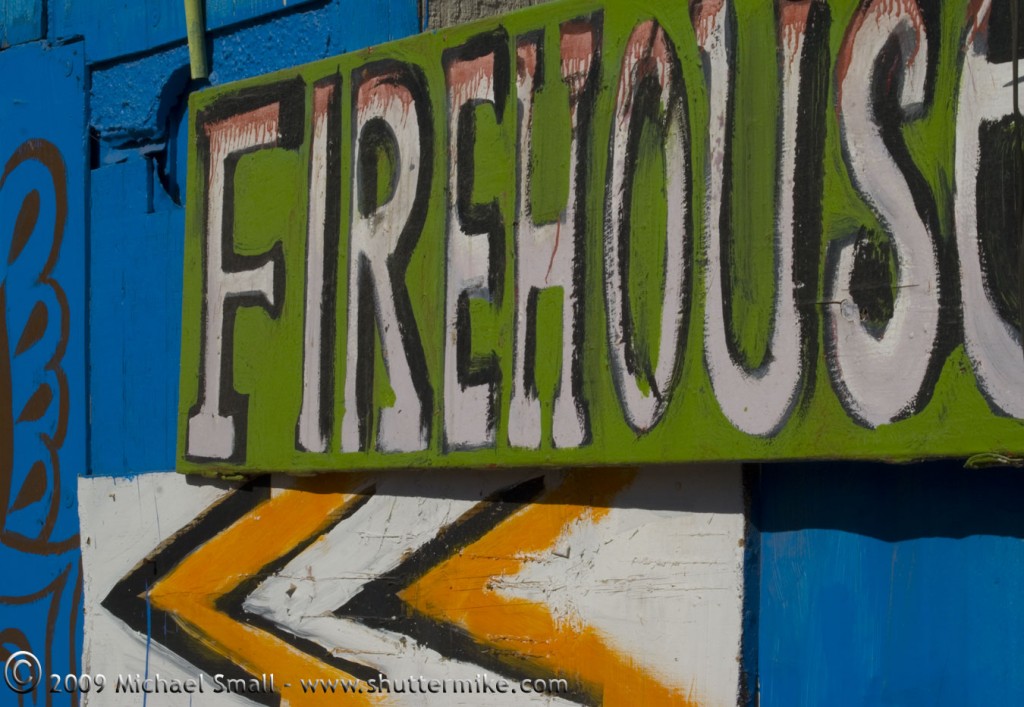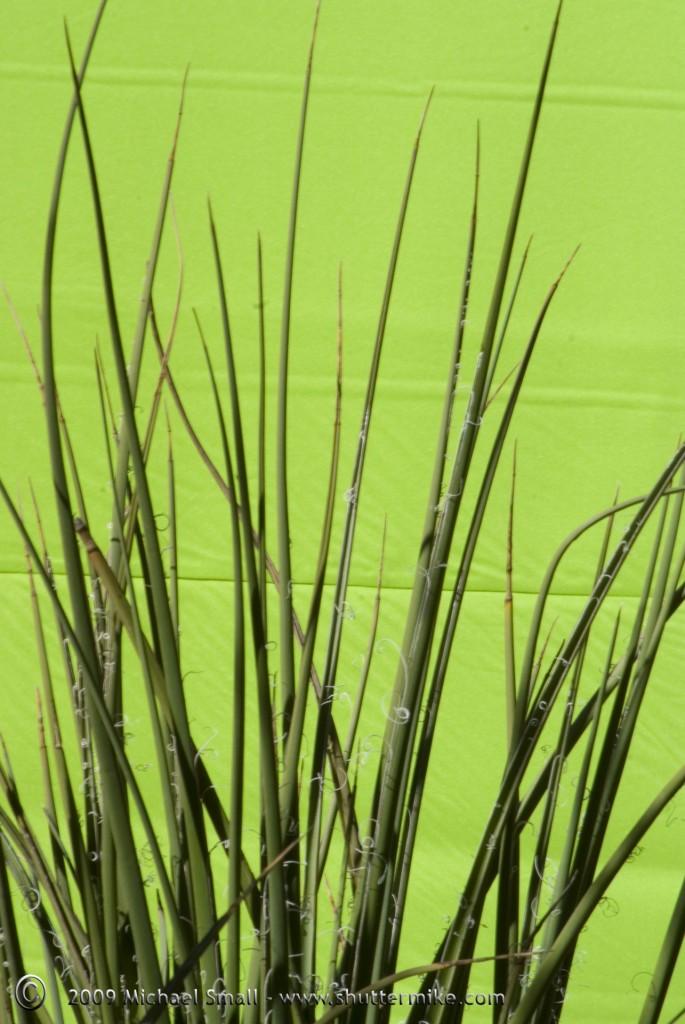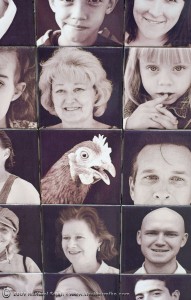 I wrote about the Tucson Portrait Project back in August when it was first revealed. It is a public art display in Tucson located where 4th Ave. passes under the railroad tracks and reemerges in downtown. I finally got a chance to see it in person this past weekend. The project website indicates it is still a work in progress. That explains why there is only one panel up at this point. But from that one panel you can tell the final completed installation is going to be awesome.
I wrote about the Tucson Portrait Project back in August when it was first revealed. It is a public art display in Tucson located where 4th Ave. passes under the railroad tracks and reemerges in downtown. I finally got a chance to see it in person this past weekend. The project website indicates it is still a work in progress. That explains why there is only one panel up at this point. But from that one panel you can tell the final completed installation is going to be awesome.
The concept is very simple, portraits of Tucsonans (and in some cases their dogs and chickens) in black and white on 4 x 4 tiles united together to form a mosaic of sorts. But that simple concept says a lot about Tucson and its residents, which I gather was the intention. The project is really well done and further enhances the revised 4th Ave underpass with its park, water features and many potential photographic subjects.
If you are in the area (which if you are in Tucson you should be at least once) it is well worth a stop to check out this public art installation.
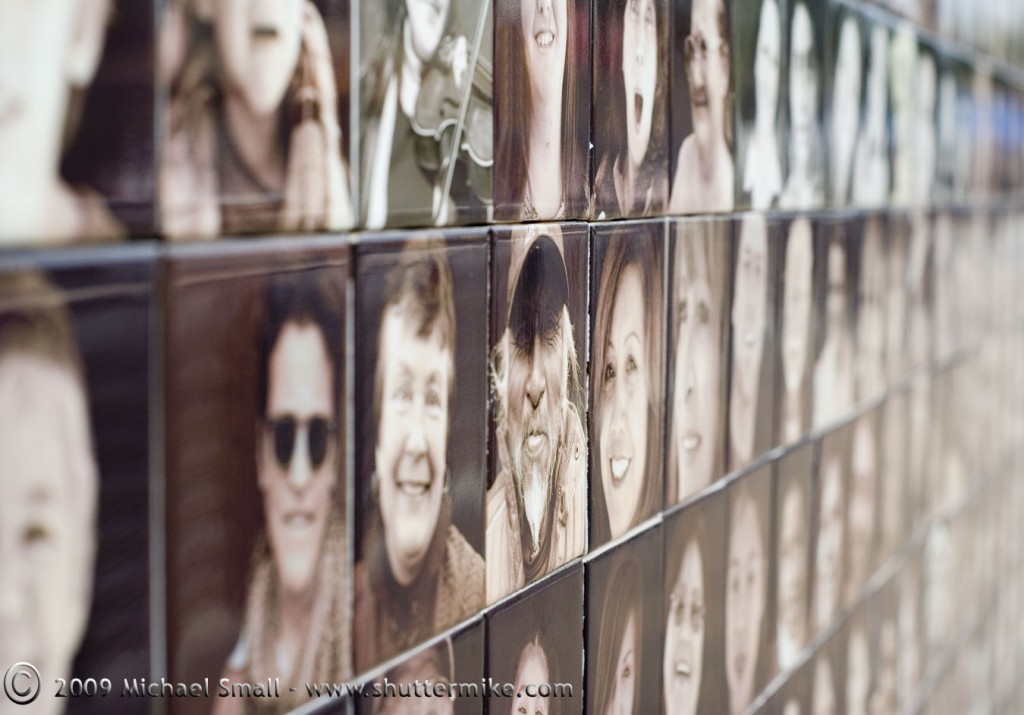
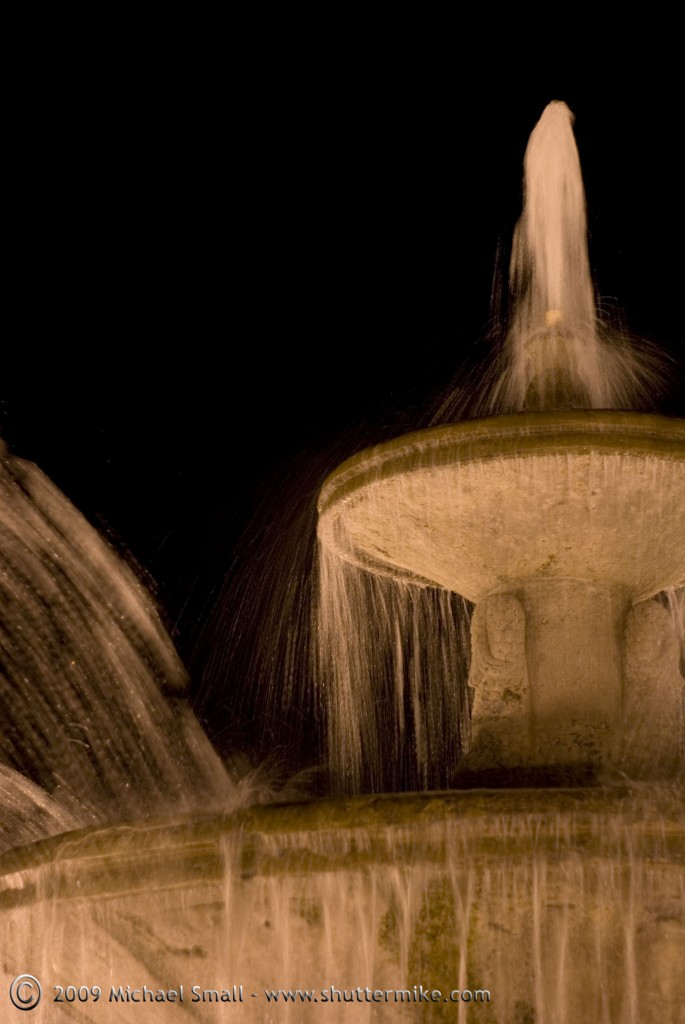
Arizona Grand Resort – Phoenix, AZ
f/2 – 1/13 sec – ISO 100 – Focal Length 50 mm
I am not posting this photograph because I think it is an exceptional image. I bought a new (to me) lens last night and was testing it out on the fountain at the Arizona Grand Resort. The lens is a Minolta which although no longer made were high quality and work with the new Sony DSLR cameras. It is a 50 mm prime (fixed) focal length with a minimum aperture of 1.7. This photograph was taken at f/2.0 with an ISO of only 100 and was hand held. I am anxious to see what I can do with the ISO pushed up a bit and a tripod. A good lens can make all the difference.
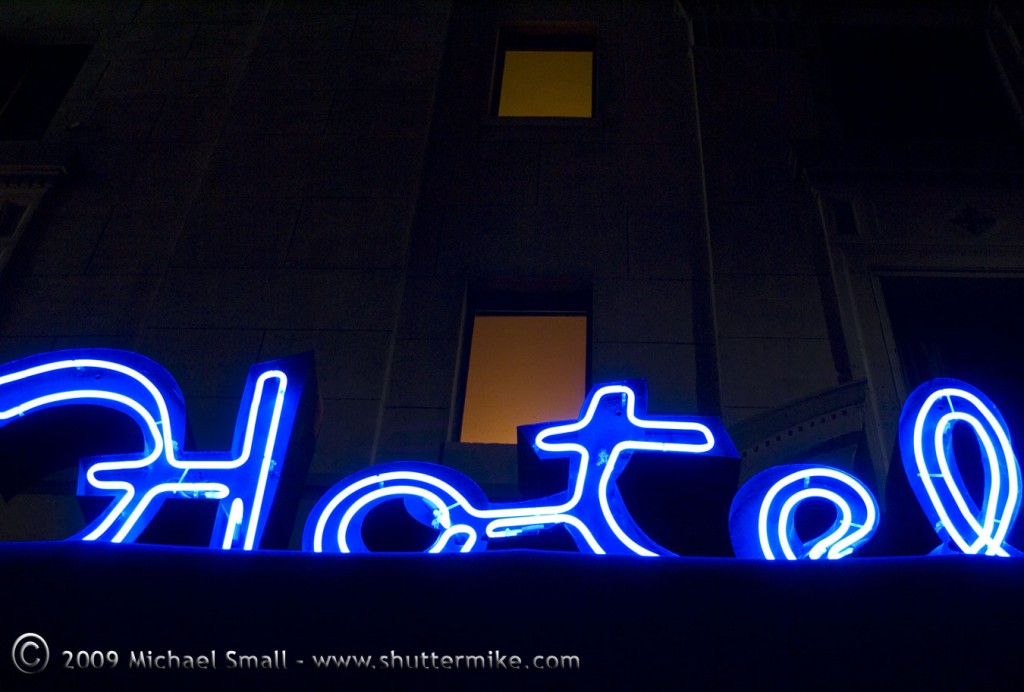 Hotel San Carlos, Downtown Phoenix, AZ
Hotel San Carlos, Downtown Phoenix, AZ
f/4.5 – 1/20 sec – ISO 400 – Focal Length 26 mm
The Hotel San Carlos opened in 1928 and still operates as a hotel in downtown Phoenix. At the time it was built it was one of Phoenix’s most modern buildings. It was the first high-rise with elevators and air conditioning. Today it is a landmark in downtown Phoenix and a popular boutique hotel.
 Duck on the pond at the Gilbert Riparian Preserve
August 2009, 6 AM
f/7.1 – 1/15 sec – ISO 100 – Focal Length 300 mm
Duck on the pond at the Gilbert Riparian Preserve
August 2009, 6 AM
f/7.1 – 1/15 sec – ISO 100 – Focal Length 300 mm
I took this photograph at the Gilbert Riparian Preserve back in August at about 6 in the morning. It is an example of why I save all but the most obviously bad and unrepairable photos that I take (a large external hard drive helps). I often go back through my images for these photo of the day posts and something that did not strike me at the time I initially did my downloading and sorting will stand out in an image.
This image is rather monochromatic, but the detail in the duck, including the drop of water coming off his beak, and the reflection of the early morning sun in the water make it an image worth a second look. So my advice is to invest in a 500 GB hard drive (they are relatively inexpensive now) and save all your photographs. You never know what a second (or third and fourth) look will reveal.
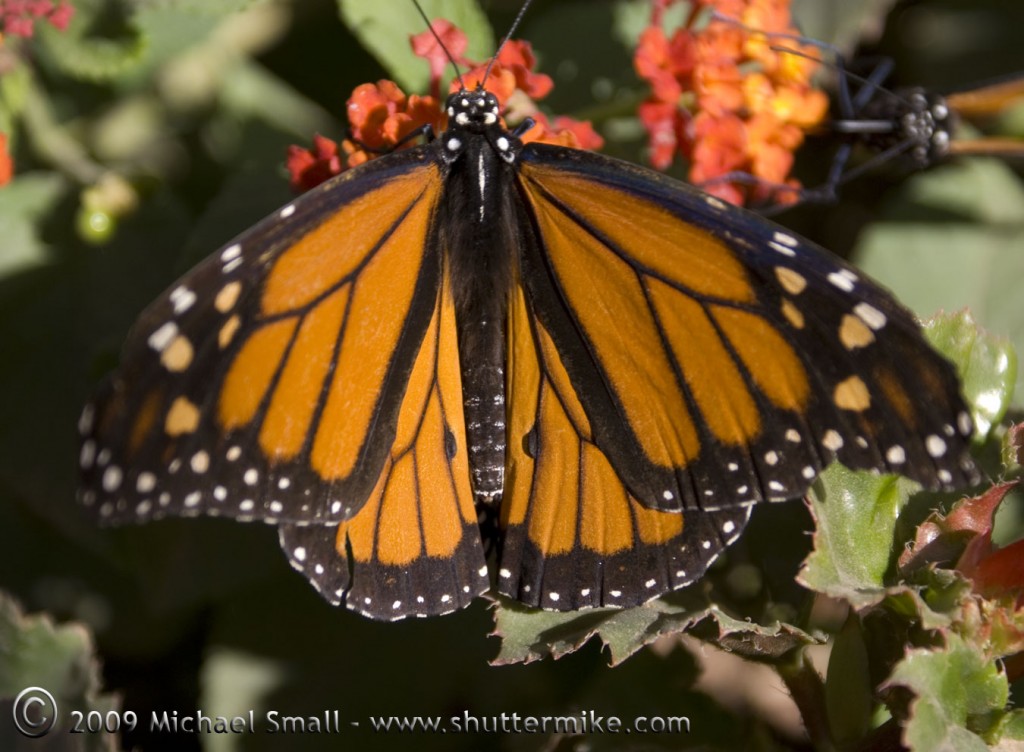 Monarch Butterfly at the Phoenix Desert Botanical Garden
Monarch Butterfly at the Phoenix Desert Botanical Garden
f/5.6 – 1/125 sec – ISO 100 – Focal Length 70 mm
The Desert Botanical Garden in Phoenix has a Monarch butterfly display every year. The enclosure houses hundreds of Monarchs and allows visitors to learn about the life cycle, migration patterns, environmental threats, and conservation efforts of this butterfly. But from the photographer’s point of view, it is an excellent opportunity to get up close to these very colorful subjects. It is a great chance to practice some macro photography and capture a subject that might be more challenging in the “wild.”
The official dictionary definition of reciprocal is “something that is equivalent to something else; counterpart; complement.” Reciprocity is a form of the word reciprocal and means “a relation of mutual dependence, action or influence.”
If you think of it in terms of a relationship it is a bit easier to understand. Here is reciprocity used in a sentence to help:
The two companies have a relationship based on reciprocity as they joined together to fight their multi-million dollar competitor.
So how do we translate that to photography? Rather simply actually. In photography reciprocity refers to the relationship between the aperture (f-stop) and shutter speed. Each f-stop has a corresponding or reciprocal shutter speed that will result in a correctly exposed image. Essentially, the smaller the aperture opening (larger the f-number) the longer the shutter speed needs to be to get the optimal amount of light to the film or digital sensor. Conversely, the larger the aperture (smaller the f-number) the shorter the shutter speed needs to be. Simply put, as one goes down the other goes up, they are inversely related. The chart below demonstrates this relationship between aperture and shutter speed. As your aperture moves closer to the “large opening” end your shutter speed will move towards the “short exposure” end. As your aperture moves closer to the “small opening” end, your shutter speed will move towards the “long exposure” end.

The reciprocal part of the relationship means that in order to maintain an accurate exposure, for each stop up or down you make in aperture (each change you make in f-stop) you need to make an equal number of stop changes for shutter speed and vice versa.
You may have heard of the term reciprocity failure as well. This is a term related to film photography and occurs when the film fails to expose correctly with very long or very short shutter speeds. This is because film is designed to work within specified shutter speeds. The result of reciprocity failure is an incorrectly exposed image. In digital photography however, reciprocity failure is not an issue. The digital sensor in DSLR cameras does not have the same limitations of film so you can focus on the reciprocal relationship of the aperture to the shutter speed.
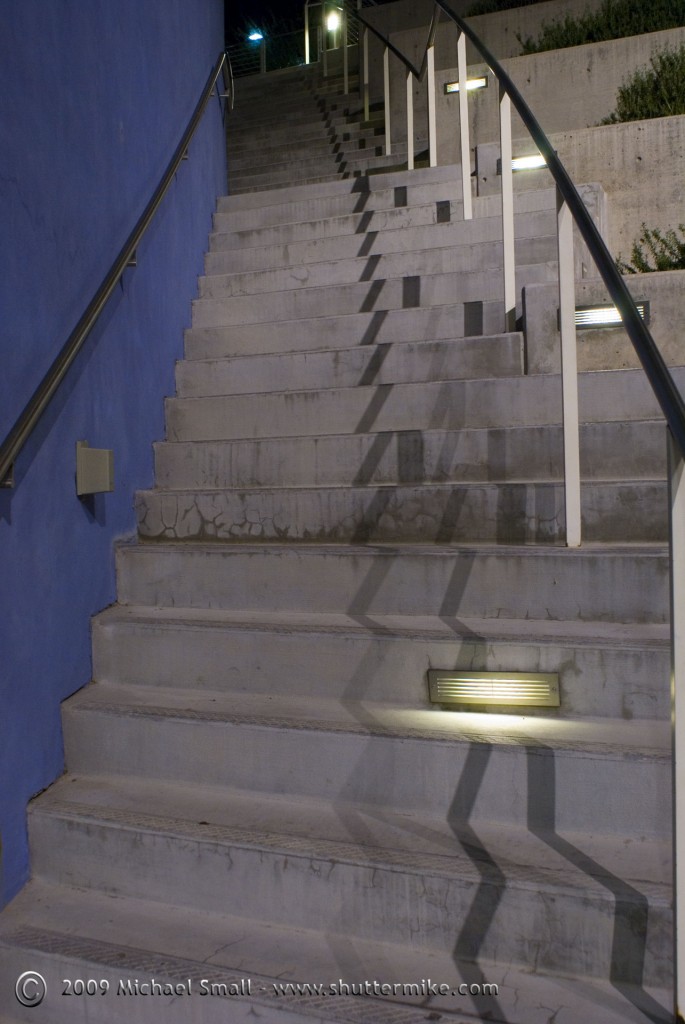 Going Up
Staircase at the Mesa Arts Center
f/7.1 – 0.4 sec – ISO 400 – Focal Length 26 mm
Going Up
Staircase at the Mesa Arts Center
f/7.1 – 0.4 sec – ISO 400 – Focal Length 26 mm
For more photos of the Mesa Arts Center check out some of my past posts such as this one (one of my favorites), or this one or even this group.
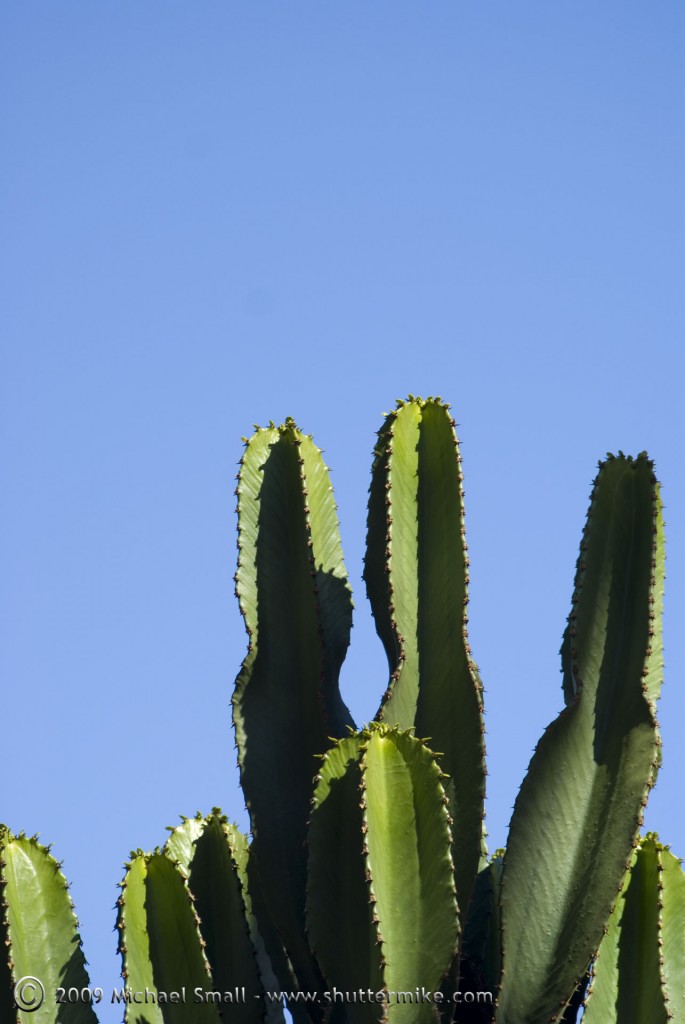 Phoenix Desert Botanical Gardens
f/6.3 – 1/250 sec – ISO 100 – Focal Length 150 mm
Phoenix Desert Botanical Gardens
f/6.3 – 1/250 sec – ISO 100 – Focal Length 150 mm
Continuing with this week’s “theme” of color this image represents analogous colors on the color wheel. That is two or more colors that are next to or adjacent on the color wheel. It also shows how the composition of a photo can be played with. The gut reaction to photographing a cactus such as this would be to either fill the frame with all cactus or step back and get it along with its surroundings. But by just capturing a small portion of the cactus against the sky I got an almost abstract image.
 I wrote about the Tucson Portrait Project back in August when it was first revealed. It is a public art display in Tucson located where 4th Ave. passes under the railroad tracks and reemerges in downtown. I finally got a chance to see it in person this past weekend. The project website indicates it is still a work in progress. That explains why there is only one panel up at this point. But from that one panel you can tell the final completed installation is going to be awesome.
I wrote about the Tucson Portrait Project back in August when it was first revealed. It is a public art display in Tucson located where 4th Ave. passes under the railroad tracks and reemerges in downtown. I finally got a chance to see it in person this past weekend. The project website indicates it is still a work in progress. That explains why there is only one panel up at this point. But from that one panel you can tell the final completed installation is going to be awesome.


